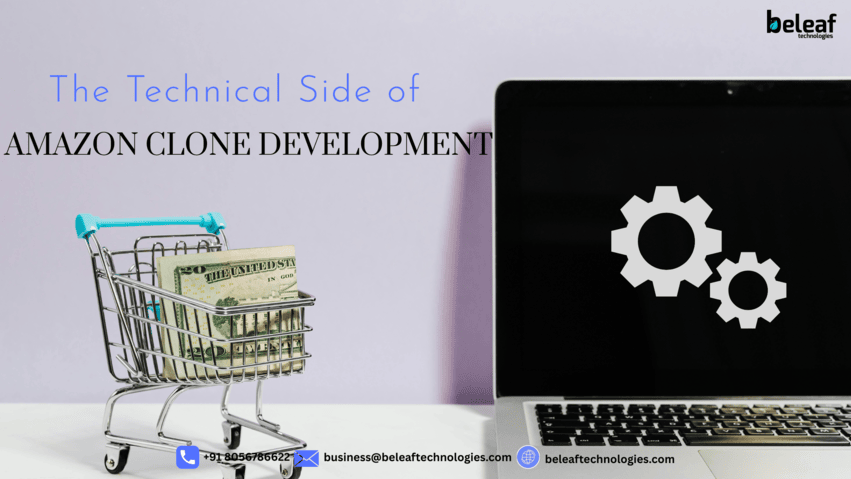Understanding the core technologies, architecture, and considerations for building an Amazon-like e-commerce platform.
Creating an Amazon-like platform is not just about replicating a design it’s about building a scalable, feature-rich system that handles thousands of users, products, and transactions. Let’s explore the technical aspects of Amazon clone development, from architecture and tech stack to developer challenges and best practices.
1. Breaking Down the Core Technologies Behind Amazon Clone Platforms
An Amazon clone is fundamentally a sizable marketplace with several vendors.To support its functionality, it relies on a combination of technologies that cover server-side operations, user interfaces, payment systems, and data management.
A standard setup often includes:
-
Frontend: HTML, CSS, JavaScript frameworks like React or Vue.js.
-
Backend: Node.js, Python (Django/Flask), or PHP (Laravel).
-
Database: Relational (MySQL, PostgreSQL) and NoSQL (MongoDB) systems.
-
APIs & Microservices: REST or GraphQL APIs for scalability and modular architecture.
The goal is to ensure that the platform can perform efficiently, even as it grows with users and vendors.
2. Recognising the Database, Frontend, and Backend Layers in an Amazon Clone
Backend Layer: This handles the logic behind product listings, user accounts, cart management, payment processing, and order tracking. It also manages vendor controls, admin dashboards, and inventory systems.
Frontend Layer: The UI needs to be quick and easy to use. Frameworks like React or Angular are commonly used to deliver dynamic and responsive experiences across web and mobile.
Database Layer: Data storage is crucial in an e-commerce platform. It is necessary to have both SQL and NoSQL databases:
-
SQL databases manage structured data like user info and orders.
-
NoSQL databases handle unstructured data such as reviews, product details, and logs.
Separating these concerns ensures better organization and smoother performance under load.
3. Tech Stack, APIs, and Infrastructure Required for Building an Amazon Clone
Choosing the right tech stack is essential. A typical Amazon clone stack might include:
-
Frontend: React.js or Next.js
-
Backend: Node.js with Express or Django
-
Database: PostgreSQL and MongoDB
-
Cloud Services: AWS, Google Cloud, or Azure
-
CDN & Storage: Cloudflare, AWS S3
-
Authentication: OAuth 2.0, JWT
-
Payment Gateways: Stripe, Razorpay, PayPal APIs
-
Search: Elasticsearch for product search and filtering
APIs are used for communication between modules this enables features like real-time updates, order syncing, third-party integrations (shipping, marketing, analytics), and mobile app support.
Infrastructure-wise, containerization tools like Docker and orchestration with Kubernetes ensure deployment scalability and fault tolerance.
4. Key Technical Considerations When Creating an Amazon-Like Marketplace
Building an Amazon clone isn’t just about coding certain key technical challenges must be addressed early:
-
Scalability: Needs to be able to manage thousands of users at once, particularly during sales.
-
Security: Secure user data, prevent fraud, encrypt transactions, and protect against SQL injection or XSS attacks.
-
Performance Optimization: Use caching (Redis, Memcached), lazy loading, and image compression for fast loading speeds.
-
SEO-Friendly Architecture: Server-side rendering (SSR), clean URLs, meta tags, and structured data for product pages.
-
Data Backup & Recovery: Set up automated backups, data redundancy, and disaster recovery mechanisms.
Each component must work together seamlessly to ensure reliability and a smooth user experience.
5. A Developer’s View of Amazon Clone Architecture and Functionality
From a developer’s perspective, an Amazon clone consists of multiple modules:
-
User Module: Sign up, login, wishlist, reviews, and orders.
-
Vendor Module: Product uploads, order management, inventory, and payments.
-
Admin Panel: User and vendor management, site settings, content moderation, and analytics.
The architecture can be monolithic in early stages but should ideally transition into microservices as the platform scales. Using services like RabbitMQ or Kafka for event handling (e.g., sending emails, updating stock) also boosts performance.
Another critical part is DevOps. CI/CD pipelines (Jenkins, GitHub Actions) automate deployment, and monitoring tools like Prometheus or Datadog help track performance and errors in real-time.
6. What Developers Need to Know Before Starting an Amazon Clone Project
Before starting development, it’s important to:
-
Outline the Features: Start by concentrating on the essential features, such as search, product pages, checkout, and vendor onboarding.
-
Choose Scalable Tools: Go for modern frameworks and cloud services that allow vertical and horizontal scaling.
-
Plan the Database Structure Carefully: Normalize data, create indexes, and define relationships clearly to avoid performance bottlenecks.
-
Focus on Testing: Unit testing, integration testing, and user testing are vital for quality assurance.
-
Ensure Compliance: Consider data regulations like GDPR or PCI-DSS, especially if handling sensitive data and payments.
Understanding these essentials helps reduce technical debt and ensures a more maintainable and robust e-commerce system.
Final Thoughts
The process of creating an Amazon clone is technically challenging. It involves careful planning, a solid understanding of web architecture, and the ability to manage scale, security, and performance. By breaking down the technical side of development, developers can make informed decisions that lead to building a reliable, scalable, and user-friendly online marketplace.




